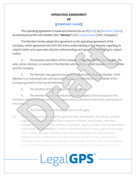Employee Confidentiality Agreements: The Ultimate Guide
Today, let's talk about an essential aspect of your business that you might not have given a second thought - Employee Confidentiality Agreements. We...
6 min read
LegalGPS : Jul. 27, 2024
Navigating the world of business relationships can be a complex voyage. One essential tool to smooth your journey is the employment agreement. But what exactly is this crucial document, what should it contain and how do you write one? Relax, you're in the right place to find out.


Employment Agreement
Craft a solid Employment Agreement with this guide covering essential terms protections and best practices for employers.
Trusted by 1,000+ businesses to safeguard their LLCs.
An employment agreement is a formal written contract between an employer and an employee. It establishes the rights, responsibilities, and obligations of both parties, offering a clear understanding of the job role, remuneration, expectations, and conditions of employment.
Having this type of agreement in place can protect not only the employer's business interests but also the rights of the employee, bringing about a healthy and legally-backed working relationship.
For an employment agreement to be effective and comprehensive, it must contain certain key components:
Job Information: This includes the employee's job title, duties, and role within the company. It should offer a thorough understanding of what the job entails. For example, a software developer might be responsible for creating new apps, maintaining existing programs, and troubleshooting technical problems. The job description should also include any additional obligations or requirements associated with the role. This can include reporting relationships, supervisory responsibilities, confidentiality agreements, and other contractual obligations.
Compensation and Benefits: It should clearly state the salary or wage the employee will earn. Information about bonuses, commission structures, and other benefits like health insurance or retirement contributions also need to be included. Its important to also include any additional compensation that might be associated with the job. This can include signing bonuses, relocation allowances, and other perks.
Schedule and Employment Period: An integral part of the employment agreement is stating the time the employee is expected to start their workday and when they're expected to end. This section also includes the terms and conditions of overtime work and pay.
Your agreement should clarify whether the employment is ongoing or set for a specific period. This helps in setting clear expectations for both the employer and employee.
Confidentiality and Privacy Policies: These are important clauses used to protect sensitive data about your company, including intellectual property and trade secrets. This section should lay out the obligations and restrictions of the employee in relation to confidentiality.
Do this by describing what information is considered confidential and how it's protected. You can also include an outline of the process for disclosing confidential information, as well as the consequences if you discover that an employee has breached your confidentiality policy.
Some employers prefer to have a separate agreement that details the terms of confidentiality or privacy policies. What aspects of the job would your employee have access to? What subjects or information do you wish to stay within the confines of your business? These answers define your confidentiality clause.
Next, we delve into the most hands-on aspect of this guide: drafting your own employment agreement.
So, you're ready to create an employment agreement that's fair, comprehensive, and to the point - fantastic! Let's turn that goal into a reality. Here's a step-by-step guide on how to fill out an employment agreement:
Prepare Ahead: Before you start jotting anything down, ensure you have a solid idea about the role, responsibilities, and requirements of the position. Create a job description outlining the important tasks the employee will perform. Gather information about the compensation package you intend to offer. And finally, detail the working hours, schedule, and workplace policies. Preparation is always a vital first step.
Begin With Basic Information: The first part of the agreement should include the names of the employee and employer, job title, and date of hire. These details lay the groundwork for the rest of the agreement.
Example:
This employment agreement entered into this day of _, 20,_ (the "Effective Date") is by and between _ (Name of Employer/Company), and _ (Name of Employee). The position for which the Employee is being hired is _ (Job Title). Clarify the Job Description: This is where you outline the role and responsibilities of the employee. Detail the tasks they are expected to perform and any performance goals they should aim to achieve.
Example:
As _(Job Title), the Employee agrees to perform the duties and responsibilities which include, but are not limited to: ...Detail the Compensation and Benefits: Clearly state the employee’s wages/salary, methods of payment, and frequency of payment. Include details about any additional benefits like health insurance, retirement contributions, or company perks. This is also the place to detail any performance-based bonuses or commission structures.
Example:
The Employee will be compensated as follows: ...Additional benefits are as follows: ...Define Duration and Hours: Express whether the employment is ongoing, temporary, or set for a certain time period. Detail the expected working hours, the potential for over-time and how that would be compensated. If there are any specific requirements like travel or relocation, this is the place to mention them.
Example:The Employee's regular working hours will be: ...The Employee's employment will begin on (date) and will end on (date/if applicable).Confidentiality, Non-Compete and Non-Disclosure Agreements: Here, outline any details about the employee's obligations regarding sensitive company information. Include any rules about future employment in the same industry if a non-compete clause is applicable.
Example:The Employee agrees to respect and protect all confidential and sensitive information obtained during the employment. Refer to our separate Confidentiality Agreement for more details.Signature and Date: Lastly, provide spaces for both parties (employer and employee) to sign and date the document, confirming their agreement to the terms and conditions outlined. The document can be signed by both parties in person, or by email. If using email, make sure to include a scanned copy of the signed agreement as an attachment.
Review: Office Legal eagle time! Review the agreement. Double-check for errors or omissions. Ensure clarity, as this document will form the basis of your professional relationship with your employee. You can also ask your employee to review the agreement and sign it if they agree with its terms. If you’re not satisfied with any changes, then go back to step 1. Once both parties have signed the document, keep a copy for your records and make sure your employee does as well.


Legal GPS Pro
Protect your business with our complete legal subscription service, designed by top startup attorneys.
And voila, you've got an employment agreement ready! Remember, the purpose of an employment agreement is to facilitate harmony, clarity, and fairness. Done well, it's more than a piece of paper – it's a foundation for great professional relationships.
Get Your Employment Agreement Template
with a Legal GPS Subscription
Now that you've got the basics of drafting an employment agreement, let's clear up some common misconceptions and pitfalls:
Ambiguity: Be as transparent as possible. Clear communication is the key to a healthy work relationship, and that starts with the employment agreement. Avoid legal jargon and make your expectations and terms of employment apparent. When in doubt, simplify.
Not complying with laws or regulations: Your agreement should align with local, state, and federal employment laws. This includes minimum wage laws, overtime regulations, and anti-discrimination legislation. A legal professional can help ensure you cover all bases.
Not considering your employee’s rights: An employment agreement should outline the basic terms of employment, including compensation and benefits. It should also include policies for vacation time, sick days, and other perks. A good contract will cover all bases so there are no surprises down the road. Ignoring termination provisions: Termination clauses can be tricky territory, especially if you have a lot of employees on staff.
Unclear expectations: If you are looking to hire an employee, make sure the agreement clearly states what tasks and responsibilities they will be taking on. If you are looking for a full-time employee, then make sure that is stated. If you have other employment needs in mind (such as temporary work), specify those as well. Avoid ambiguity when possible so there is no confusion about what each party expects from the other.
Ignoring company culture or values: Remember, your agreement also communicates what your company represents. It should reflect your company's mission, values, and culture.
Ignoring industry standards: Your agreement should reflect industry standards for hiring, benefits, compensation, and other terms of employment. For example, if you're in the technology industry and your agreement doesn't include a non-compete clause, it may be considered unprofessional.

Employment Agreement
Craft a solid Employment Agreement with this guide covering essential terms protections and best practices for employers.
Trusted by 1,000+ businesses to safeguard their LLCs.
Next up, let’s wrap things up!
A well-drafted employment agreement isn't just about compliance with laws - it's about creating clarity in business relationships, setting expectations right, and mitigating future conflicts. By understanding its purpose, key components and common pitfalls, you're well on your way to creating an agreement that fosters a positive work environment.
However, as handy as guides like this are, nothing replaces professional advice. Consider this post a stepping stone towards understanding employment agreements better and a call to seek advice when you need it. Remember, a stitch in time saves nine - and an agreement checked now, saves (legal) trouble later on!
Still unsure about drafting your own agreement? Check out our ready-to-use employment agreement templates, expertly crafted to save you time while providing you with legal peace of mind. Available on a different webpage, they’re tailored to streamline your entrepreneurial journey and simplify the legal aspects of running your business. Don't forget, we're your co-pilot on your legal journey!
The biggest question now is, "Do I need a business lawyer?” For most businesses and in most cases, you don't need a lawyer to start your business. Instead, many business owners rely on Legal GPS Pro to help with legal issues.
Legal GPS Pro is your All-In-One Legal Toolkit for Businesses. Developed by top startup attorneys, Pro gives you access to 100+ expertly crafted templates including operating agreements, NDAs, and service agreements, and an interactive platform. All designed to protect your company and set it up for lasting success.
Get Legal GPS's Employment Agreement Template Now

Legal GPS Pro
Protect your business with our complete legal subscription service, designed by top startup attorneys.
|
Premium Template
Single-use Template |
Legal GPS Pro
Unlimited Access, Best Value |
|
|
| Choose Template | Learn More |
| Trusted by 1000+ businesses | |

Today, let's talk about an essential aspect of your business that you might not have given a second thought - Employee Confidentiality Agreements. We...

In today's rapidly evolving business landscape, protecting your company's trade secrets, intellectual property, and client relationships is more...

This guide will help you minimize the risks involved in disciplining and terminating an employee. It'll give you a strong understanding of your...